Advanced Dental Services & Technology Parsippany
Using the Latest Dental Technology to Deliver Phenomenal Results
Whether you visit us for a routine checkup and cleaning or to get dental implants, we’re able to deliver extraordinary care by equipping our office with the latest dental technology available. Our digital X-ray imaging system, cone beam CT scanner, cavity detection system, and countless other gadgets are able to make each of your appointments and treatments more thorough, effective, comfortable, and faster. To learn more about what instruments we have in our dental office, take a look below.
Laser Dentistry

Our Beamer STL 980 soft tissue laser allows us to more comfortably provide frenectomies, gum disease treatment, and gum recontouring in-house without the use of a scalpel or sutures. Instead of cutting, the soft tissue laser dissolves the tissue in an instant and cauterizes the area on-contact, minimizing post-operative risk of infection, bleeding, and even healing times.
What Are Dental Lasers?
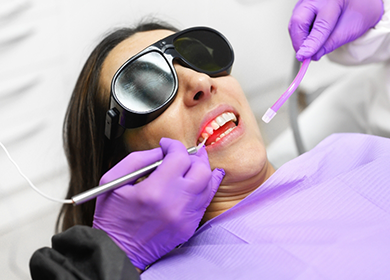
Essentially, a laser is a highly concentrated beam of light. Here at Rauchberg Dental Group, our practice features the Beamer STL 980, a diode laser that converts electrical energy into laser light. It has been on the market for more than 15 years and has a strong record of dentist and patient satisfaction. It is a soft tissue laser, meaning that it is used to carry out treatments on the soft tissues in the mouth, such as the gums.
Types of Laser Dental Treatments
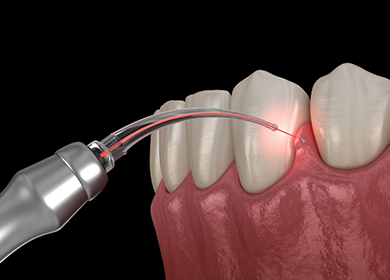
Dental lasers can be used to carry out a range of treatments. In our practice, we use the Beamer STL 980 to complete frenectomies (lip and tongue tie treatment), periodontal therapy, and gum recontouring. Here is a bit more information on how these advanced treatments work:
Lip & Tongue Tie Treatment
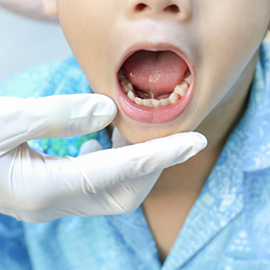
If you or your child has restricted movement of your lips or tongue due to a large or thick band of connective tissue (called a frenulum or frenum), we may use our laser to perform a simple surgery known as a frenectomy. Essentially, we cut the restrictive tissue in order to free up movement of the oral structures and allow them to function optimally.
Gum Disease Treatment
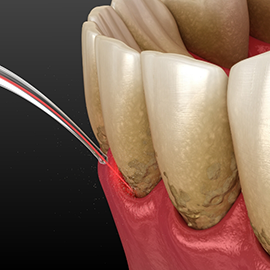
When harmful bacteria invade the gum tissue, gum disease can wreak havoc on a person’s oral and overall health. If you have this condition, we may use our laser to kill those invasive bacteria, remove diseased tissue, and get your smile on the road to recovery.
Gum Recontouring
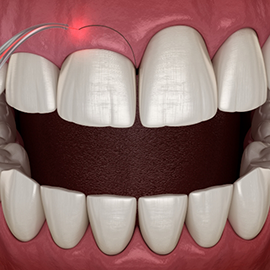
If more than a few millimeters of gum tissue are visible when you smile, you have what is known as a “gummy smile.” Very often, we can correct this cosmetic issue by using laser technology to trim the gums in a way that makes the teeth appear longer and creates a more proportionate, more attractive overall appearance.
The Benefits of Laser Dentistry
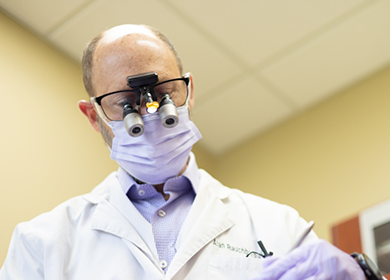
Some of the most remarkable benefits of laser dentistry include:
- It tends to be much more precise than procedures performed with traditional instruments.
- The laser cauterizes the tissue as it moves, which means there is little to no bleeding.
- Recovery times after laser-based treatments tend to be faster than after treatments performed with traditional instruments.
- In many cases, we are able to use minimal anesthesia during laser-based procedures.
- Because of the laser’s remarkable ability to kill bacteria, it minimizes the risk of infections.
- Sutures are usually not needed after a laser treatment.
- Laser treatments tend to be fast, which can allow you to save time.
Overjet AI
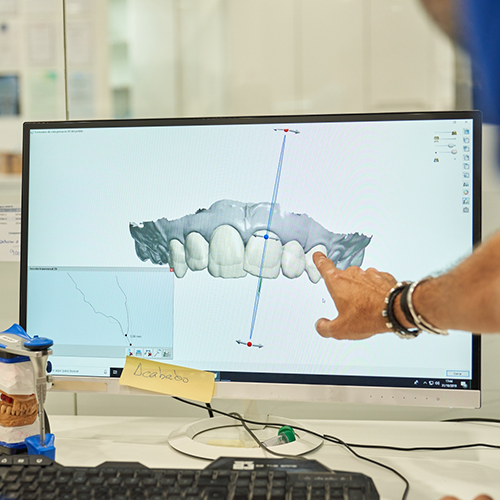
Overjet AI is an advanced dental software that’s quickly emerging as one of the best and most precise ways to examine digital X-rays. It’s a technology that compares your X-rays to hundreds of thousands of other ones, allowing our team to not only make diagnoses with complete confidence, but also preventing the oversight of any early signs of problems that we may not be able to spot with the naked eye. This extreme precision allows us to keep your oral health on the right track every time you come see us.
Digital X-Rays
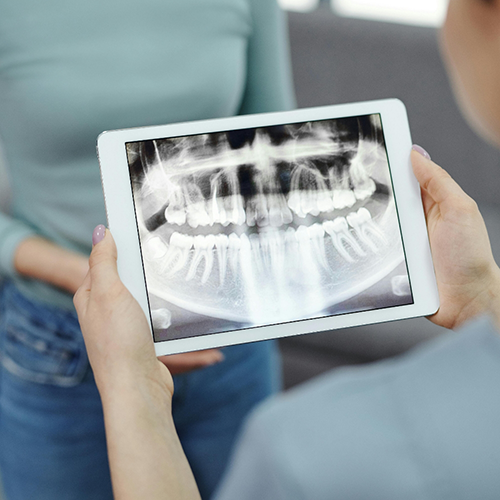
In the past, dentists used film X-ray imaging systems to capture pictures of the area of your mouth that lies below your gumline. These would take longer to develop, use harmful chemicals, and produced pictures that weren’t always clear. Today, we use advanced digital X-ray imaging, which reduces radiation exposure by up to 90 percent and makes each of your checkups more thorough than ever by producing crystal-clear images. In addition to all of these benefits, they’re also easier to store and transfer in the form of digital files!
Intraoral Camera
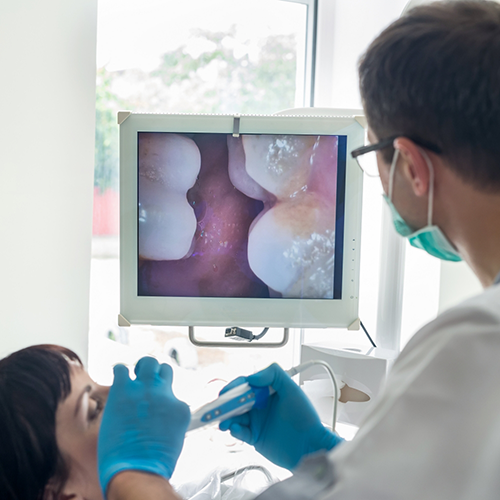
Our intraoral camera is a small, handheld device that we can maneuver around your mouth to capture video footage and pictures of hard-to-see crevices and areas. It’s connected to a large, chairside monitor that allows you to see the same footage that we are. That way, you can see for yourself what problems you’re facing, and we can better explain how our recommended treatment can take care of them.
CBCT Scanner
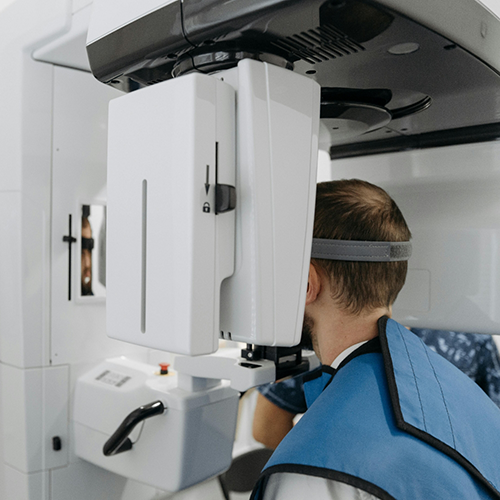
Our cone beam CT scanner is an advanced imaging device that takes a panoramic picture of your facial structure. It doesn’t just capture the area below your gums—it also shows us dentition, the location of your facial nerves and sinuses, and both of your complete jawbones. This allows us to plan advanced treatments more thoroughly, like dental implant placement, with minimal risk of encountering any complications and allowing us to achieve ideal results.
Digital Impression System
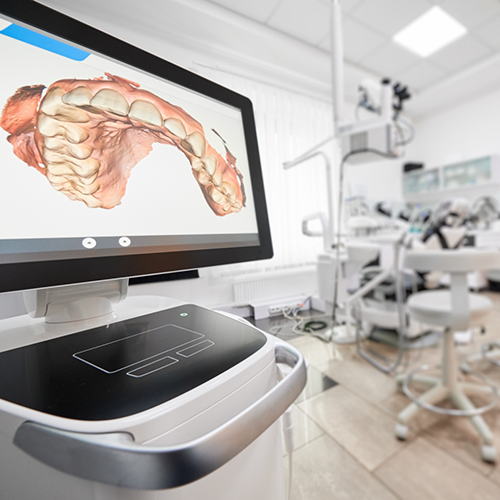
Have you ever had to get an uncomfortable putty impression taken to get a mouthguard or restoration crafted? When you visit Rauchberg Dental Group, you’ll quickly realize that uncomfortable methods of crafting restorations are obsolete. We use advanced digital imaging to craft a detailed blueprint of your dental structure or oral cavity to craft perfectly fitted prosthetics and mouthguards without causing you to gag.
Cavity Detection System

Many patients aren’t aware that cavities can form in hard-to-see areas, like between the teeth. Unfortunately, these can be hard to spot with the naked eye, even a professionally trained one. That’s why we use our cavity detection system during your checkups to make sure that any sign of dental decay is treated before it has a chance to progress. All we have to do is shine a light in your mouth, and it will illuminate the enamel. In areas where the light gets absorbed, we know that there’s decay present.
